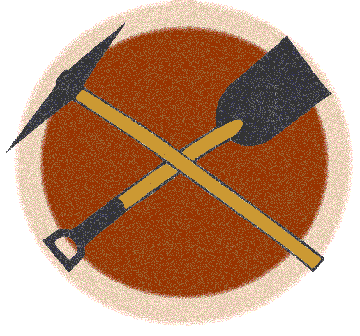The Colorado Coalfield War Archaeological Project
Digital Atlas
Maps
Glossary
Artifact: any material or object that can be removed from the archaeological matrix without destroying it. Examples include bottles, ceramics, or nails.
Artifact Groups:
-Architecture: any materials related to the construction of buildings, such as nails, bolts, screws, and window glass.
-Clothing: any materials related to clothing, such as belt buckles or buttons.
-Commemorative: any materials related to the memorialization or celebration of an place or event.
-Electrical: any materials related to electrical services such as wire or insulators.
-Fencing: any materials related to fencing such as barbwire.
-Firearms: any materials related to firearms such as gun parts, bullets, or shells.
-Food related: any materials related to the preparation or consumption of food such as bottle glass, tin cans, utensils, or ceramic vessels.
-Furniture: any materials related to furniture or hardware such as handles or stands.
-Industrial: any materials related to the industrial practices of mining such as miners' tags or mining tools.
-Other: any materials not specifically related to any other group.
-Personal: any materials related to personal activities such as hygiene, combs, or toiletries.
-Recreation: any materials related to recreational activities such as toys or game pieces.
-Tool: any material related to work or construction activity such as picks, shovel, or hammers
-Transportation: any materials related to transportation or travel technology such as horseshoes or wagon parts.
-Writing: any materials related to writing practices such as pencils or inkwells.
Checkweighmen: a representative of the miners to assure that the scales used to weigh the coal mined was accurate and that miners were getting fair compensation for coal mined.
Coke: The remains of coal after the coking process, which heats and oxidizes coal. Coke was used in steel plants to get temperatures higher than regular coal needed in the production of steel.
Deadwork: miners' work not directly associated with the mining of ore or coal, such as laying of track, or timbering the mine tunnels.
Ground Penetrating Radar: a method of survey using an instrument to measure the presence of disturbance in the natural soil. The instrument sends a radar signal into the ground with the signal returning after bouncing off of any disturbed or alterations in the soil matrix. These differences in the matrix can be associated with features or areas disturbed by people in the past.
Feature: any material or collection of material that will be destroyed if it or pieces of it are removed. Examples include structures, buildings, trash pits, or ditches.
Industrial Democracy: a corporate system popular in the early twentieth century in which employees negotiated with management over company supplied social services.
Industrial Paternalism: a corporate system popular in the early twentieth century in which employees relied on the company owners for basic social services.
Magnetometer: A method of survey that uses an instrument to measure differences in magnetic fields for a tested area. These different levels of magnetism are often associated with large amounts of metallic or burned material suggesting the presence of artifacts or features.
Midden: A pile of trash or dumping area for refuse.
Planview: An overview map or illustration of an area under excavation or a feature.
Profile: A side view of an excavated area that shows the layers of soil or sediment deposition for that area of the site.
Survey: The methods and practice of archaeologists to identify the presence of historic or prehistoric sites. Within sites techniques are used to identify features.




